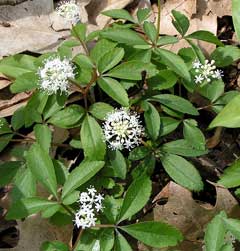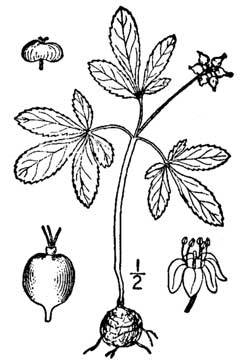 |
|
www.flickr.com/photos/jlucier |
 |
| USDA-NRCS PLANTS Database / Britton, N.L., and A. Brown. 1913. Illustrated flora of the northern states and Canada. Vol. 2: 619. |
Translate this page:
Summary
Physical Characteristics

 Panax trifolius is a PERENNIAL growing to 0.2 m (0ft 8in).
Panax trifolius is a PERENNIAL growing to 0.2 m (0ft 8in).
See above for USDA hardiness. It is hardy to UK zone 3. It is in leaf from April to June, in flower in April. The species is hermaphrodite (has both male and female organs).
Suitable for: light (sandy), medium (loamy) and heavy (clay) soils. Suitable pH: mildly acid, neutral and basic (mildly alkaline) soils. It can grow in full shade (deep woodland) or semi-shade (light woodland). It prefers moist soil.
UK Hardiness Map
US Hardiness Map
Synonyms
Aralia trifolia.
Plant Habitats
Woodland Garden Dappled Shade; Shady Edge; not Deep Shade;
Edible Uses
Edible Parts: Root
Edible Uses:
Root - cooked[57, 63]. A very palatable taste after being boiled[183]. When cold it has a taste somewhat like nuts[183].
References More on Edible Uses
Medicinal Uses
Plants For A Future can not take any responsibility for any adverse effects from the use of plants. Always seek advice from a professional before using a plant medicinally.
Miscellany
Although closely related to the well-known herbal medicine ginseng, this species has been little researched for its medicinal virtues[222]. A tea made from the whole plant has been used in the treatment of colic, indigestion, gout, hepatitis etc[222]. The root is analgesic[257]. It has been chewed as a treatment for headache, short breath, fainting and nervous debility[222, 257].
References More on Medicinal Uses
The Bookshop: Edible Plant Books
Our Latest books on Perennial Plants For Food Forests and Permaculture Gardens in paperback or digital formats.

Edible Tropical Plants
Food Forest Plants for Hotter Conditions: 250+ Plants For Tropical Food Forests & Permaculture Gardens.
More

Edible Temperate Plants
Plants for Your Food Forest: 500 Plants for Temperate Food Forests & Permaculture Gardens.
More

More Books
PFAF have eight books available in paperback and digital formats. Browse the shop for more information.
Shop Now
Other Uses
References More on Other Uses
Cultivation details
Requires a moist humus-rich soil in a shady position in a woodland[1, 200]. The plant has leaves above the ground for only two months each year[222]. Although plants are hermaphrodite, individual flowers are often male[200]. For polyculture design as well as the above-ground architecture (form - tree, shrub etc. and size shown above) information on the habit and root pattern is also useful and given here if available. The plant growth habit is a runner spreading indefinitely by rhizomes or stolons [1-2]. The root pattern is tuberous with swollen potato-like roots [1-2].
References Carbon Farming Information and Carbon Sequestration Information
Temperature Converter
Type a value in the Celsius field to convert the value to Fahrenheit:
Fahrenheit:
The PFAF Bookshop
Plants For A Future have a number of books available in paperback and digital form. Book titles include Edible Plants, Edible Perennials, Edible Trees,Edible Shrubs, Woodland Gardening, and Temperate Food Forest Plants. Our new book is Food Forest Plants For Hotter Conditions (Tropical and Sub-Tropical).
Shop Now
Plant Propagation
Seed - sow in a shady position in a cold frame preferably as soon as it is ripe, otherwise as soon as the seed is obtained. It can be very slow and erratic to germinate. Prick out the seedlings into individual pots when they are large enough to handle and grow them on in a shady position in the greenhouse or frame for at least their first winter. Make sure the pots are deep enough to accommodate the roots. Plant out into their permanent positions in late summer. Division in spring.
Other Names
If available other names are mentioned here
Native Range
NORTHERN AMERICA: Canada, Québec (south), Nova Scotia, Ontario (south), Prince Edward Island, New Brunswick, United States, Connecticut, Indiana, Maine, Massachusetts, Michigan, New Hampshire, New Jersey, New York, Ohio (north), Pennsylvania, Rhode Island, Vermont, West Virginia, Minnesota (e.-c.), Wisconsin, Georgia (northwest), Kentucky, Maryland, North Carolina, Tennessee, Virginia,
Weed Potential
Right plant wrong place. We are currently updating this section.
Please note that a plant may be invasive in one area but may not in your area so it's worth checking.
Conservation Status
IUCN Red List of Threatened Plants Status :

Growth: S = slow M = medium F = fast. Soil: L = light (sandy) M = medium H = heavy (clay). pH: A = acid N = neutral B = basic (alkaline). Shade: F = full shade S = semi-shade N = no shade. Moisture: D = dry M = Moist We = wet Wa = water.
Now available:
Food Forest Plants for Mediterranean Conditions
350+ Perennial Plants For Mediterranean and Drier Food Forests and Permaculture Gardens.
[Paperback and eBook]
This is the third in Plants For A Future's series of plant guides for food forests tailored to
specific climate zones. Following volumes on temperate and tropical ecosystems, this book focuses
on species suited to Mediterranean conditions—regions with hot, dry summers and cool, wet winters,
often facing the added challenge of climate change.
Read More
Expert comment
Author
L.
Botanical References
43200
Links / References
For a list of references used on this page please go here
Readers comment
© 2010, Plants For A Future. Plants For A Future is a charitable company limited by guarantee, registered in England and Wales. Charity No. 1057719, Company No. 3204567.